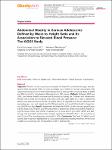Abdominal Obesity in German Adolescents Defined by Waist-to-Height Ratio and Its Association to Elevated Blood Pressure: The KiGGS Study
Kromeyer-Hauschild, K.
Neuhauser, Hannelore
Rosario, Angelika Schaffrath
Schienkiewitz, Anja
Objective: The aim of this study was to compare the fixed 0.5 cut-off and the age- and sex-specific 90th percentile (P90) for waist-to-height ratio (WHtR) in German adolescents with respect to the prevalence of abdominal obesity and to compare the screening ability of WHtR and BMI to identify hypertensive blood pressure (BP) values. Methods: Between 2003 and 2006, the German Health Interview and Examination Survey for Children and Adolescents (KiGGS) was carried out including 3,492 boys and 3,321 girls aged 11-17 years. Abdominal obesity was assessed by two WHtR cut-points (P90; 0.5). Hypertensive BP was defined as BP exceeding age-, sex- and height-specific 95th percentiles or the adult threshold for hypertension (140/90 mm Hg). Results: Agreement between the WHtR cut-offs was very good (Kappa 0.89 for boys; 0.81 for girls), and the prevalence of abdominal obesity was slightly higher using P90 (boys 12.0%; girls 11.3%) compared to 0.5 (boys 10.7%; girls 8.0%). WHtR and BMI-for-age had equivalent ability to discriminate hypertensive BP (ROC-AUC < 0.7; sensitivity of the 0.5 cut-off for detecting hypertensive BP < 30%). Conclusion: The fixed 0.5 WHtR cut-off can be used in German adolescents to characterize abdominal obesity. However, WHtR is not suitable as a screening tool for hypertensive BP in adolescents. Copyright © 2013 S. Karger GmbH, Freiburg.
Dateien zu dieser Publikation
Keine Lizenzangabe

